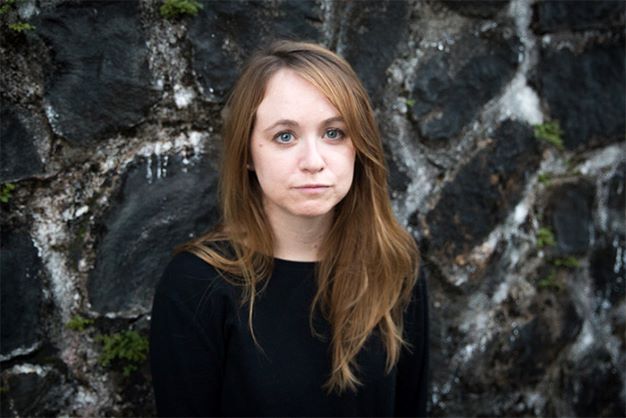Author Hayden describes discovery of massive refugee camps in Libya
Sally Hayden, Africa correspondent for The Irish Times and author of "My Fourth Time, We Drowned: Seeking Refuge on the World's Deadliest Migration Route," told a Headliners Book Event April 29 how an anonymous Facebook message led to the book.
The message launched her down a path to expose mass atrocities in detention centers in Libya, ignored by governments, out of sight of most people and worsening by the day, she said.

The unexpected message had come from a man locked inside a prison which, he claimed, was holding 500 men, women and children in Tripoli, Hayden said.
Hayden was in London. “It just came out of nowhere,” she said. “I didn’t know what to make of this. I was pretty skeptical. Why would they contact me?”
The sender explained that his brother knew Hayden’s journalism from Sudan and had traced her contact details online, she said.
“What had emerged is that they had pretty much all tried to cross the Mediterranean Sea to reach Europe, but they had been intercepted and they had been forced back to Libya, where they have been kept indefinitely,” Hayden said of the detainees. “There has been no legal charge, no legal recourse to contest this detention.”
War had broken out and the guards who had locked the prisoners in had fled, leaving no food or water. The detainees were panicking, Hayden said. “They were begging for someone to help them.” She explained to them that as a journalist she could not help, but she would listen to their story.
Hayden contacted a reporter she knew in Tripoli and started verifying stories. She began tracking down other sources, including officials at the United Nations and the European Commission. She put some of her findings on Twitter, which led to hundreds more contacts from inside other prisons.The posts had gone viral, she said.
“I had stumbled, inadvertently, on a human rights disaster of epic proportions,” Hayden wrote in her book.
Another startling reality that emerged led to Hayden’s moment of realization, she said in last week’s discussion, “This had happened as a result of European Union policy.”
European Union countries were using their own drones, helicopters and other aircraft to surveil the Mediterranean for boats carrying migrants. EU operators would give the locations to the Libyan “coast guard” (she explained that the term actually encompasses disparate groups, some run by militias and some by known human smugglers), which would then intercept the boats and force its occupants back to Libya ,where they would be incarcerated indefinitely, she said.
“We say ‘coast guard’,” Hayden said, but “it has been a collection of people who have sided with different groups, often militias, or have been implicated or actually involved in smuggling.”
Hayden said the EU began washing its hands of the African migration problem in 2015, when it launched the Trust Fund for Africa, a multibillion euro pot of money aimed at stopping migration to Europe.
The book has a timeline that includes a reference to Italy agreeing in 2017 to work with the Libyan coastguard “to stem the influx of illegal migrants.” On its website, the European Commission describes the EU Trust Fund for Africa as being “created to address the root causes of instability, forced displacement and irregular migration and to contribute to better migration management.”
But Hayden told people in the Zoom discussion that she sought out interviews with EU spokespersons and was told, in essence, “It’s not our responsibility to figure out what happens to people once they get sent back (to Libya).”
People in the detention centers mostly came from other African countries and were fleeing either dictatorships, famine, violence, war, almost certain death; or they were considered “economic migrants,” mostly coming from West Africa fleeing poverty. “They would have been considered refugees if they had had a chance to make that claim,” Hayden said.
Elizabeth Hagedorn, chair of the club’s international correspondents committee, moderated the discussion with Hayden, who spoke from Dublin via Zoom.
Hagedorn asked what the international community’s response to the situation has been. “Is anyone monitoring this? Is there an organization tracking the number of deaths?”
The response: No one. “That was the big question, she said. “Who’s counting the number of deaths? There isn’t a register of who’s inside them. People get locked up inside, but no one takes their names.”
There are a documented 90,000 prisoners in Libya in the various prison facilities, which Pope Francis in 2020 called “concentration camps,” according to Hayden.
“There’s been a pretty deliberate effort to make sure that we’re not getting information out of those detention centers,” Hayden said. “Journalists manage to get in but those are quite heavily stage managed,” she said. “Detainees know if they speak to a journalist, they will get punished afterwards.”
In advance of a visit, she said, prison guards would turn on the electricity, launch massive cleanups and allow detainees to play football outside, all for show. But a handful of hidden cell phones have shown otherwise, she said. She detailed how she verified stories from within the various prisons by separately contacting detainees who don’t know each other. Many times, unprompted, the second source would tell the same story as the first. Some sources sent photographs taken with secret phones. Comparing stories from various sources from within prison walls was just one step she would take to verify their veracity. She would also seek to corroborate other factors to see if the story made sense overall.
